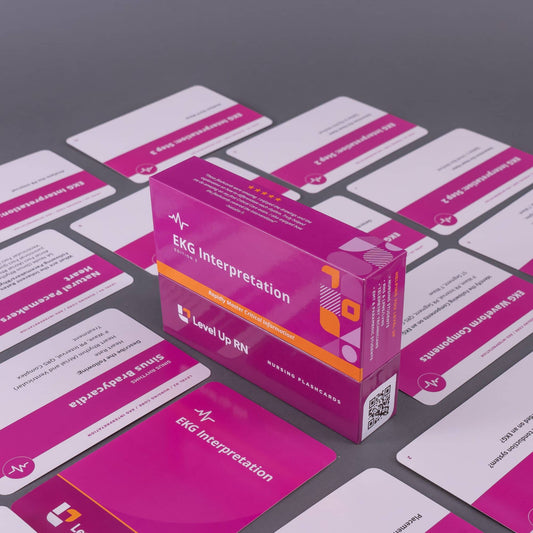In this article, we cover the natural pacemakers in the heart. The EKG Interpretation video series follows along with our EKG Interpretation Flashcards, which are intended to help RN and PN nursing students study for nursing school exams, including the ATI, HESI, and NCLEX.
EKG Interpretation - Nursing Flashcards
The SA Node (Sinus Node)
The sinus node is one of the major elements in the cardiac conduction system. It is the heart’s natural pacemaker and generates a sinus rhythm. A sinus rhythm is any cardiac rhythm in which depolarisation of the cardiac muscle begins at the sinus node. It is characterised by the presence of correctly oriented P waves on an EKG.
We are just introducing you to the sinus rhythm here, but you can learn everything you need to know about them in our in-depth article on sinus rhythms in this series.
Rate of a sinus rhythm
The inherent rate of a sinus rhythm is between 60 and 100 beats per minute. Sinus rates below this range are termed sinus bradycardia and sinus rates above this range are termed sinus tachycardia.
Key characteristics
The key characteristics of a sinus rhythm include P waves that are upright and uniform in appearance, and there will be one P wave for each QRS complex. If the sinus node fails, then the atrial foci will take over and create an atrial rhythm.
Atrial foci
The atrial foci are abnormal pacemaker sites within the heart that are outside the SA node and are an automatic response if the sinus node fails. They are the first backup if the sinus node fails.
The atrial foci create an atrial rhythm, which originates in the atria rather than in the SA node. The P wave will be positive, but its shape can be different than a normal sinus rhythm because the electrical impulse follows a different path to the AV or atrioventricular node.
We are just introducing you to atrial rhythms here, but you can learn everything you need to know about them in our in-depth article on atrial rhythms in this series.
Rate of a atrial rhythm
The atrial rhythm's inherent rate is between 60 and 80 beats per minute.
Key characteristics
The key characteristics of an atrial rhythm include abnormal P waves, or instead of P waves, we may get atrial fibrillation or flutter waves instead. Then if the atrial foci fails, the junctional foci take over.
Junctional foci
Junctional foci are located in the AV or atrioventricular junction and create a junctional rhythm. A junctional rhythm is where the heartbeat originates from the AV node or His bundle, which lies within the tissue at the junction of the atria and the ventricle.
The junctional rhythm is the second backup for the heart in the case that both the sinus node and atrial foci fail.
We are just introducing you to junctional rhythms here, but you can learn everything you need to know about them in our in-depth article on junctional rhythms in this series.
Rate of a junctional rhythm
The junctional rhythm's inherent rate is between 40 and 60 beats per minute. Learn more about accelerated junctional rhythms, junctional tachycardia, and junctional bradycardia.
Key characteristics
The key characteristics of a junctional rhythm include inverted or absent P waves, P waves that occur after the QRS complex, or PR intervals that are abnormally short. Then if the junctional foci fails, the ventricular foci take over and create a ventricular rhythm.
Ventricular foci
A ventricular rhythm is a cardiac rhythm characterized by a rate of less than 50 beats per minute, absence of P waves and widening of the QRS complex.
We are just introducing you to ventricular rhythms here, but you can learn everything you need to know about them in our in-depth article on ventricular rhythms in this series.
Rate of ventricular rhythm
The inherent rate of a ventricular rhythm is very slow, between 20 and 40 beats per minute.
Key characteristics
The key characteristics of a ventricular rhythm include no P waves and abnormally wide QRS complexes. We cover some ventricular rhythms including premature ventricular complex (PVC) and ventricular tachycardia later in this series.



1 comment
Very helpful.